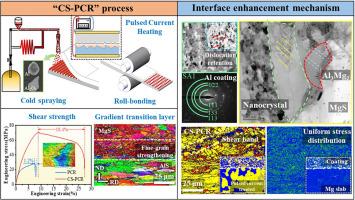脉冲电流辅助轧制Mg/Al层压板颗粒间层界面纳米晶强化机制
IF 13.8
1区 材料科学
Q1 METALLURGY & METALLURGICAL ENGINEERING
引用次数: 0
摘要
界面过渡区和界面影响区是决定非均相金属层合板界面结合强度和延性的关键因素。在本研究中,提出了一种创新的工艺-“冷喷涂+脉冲电流轧制”,用于制造Mg/Al层压板,显着提高了界面强度和延展性。值得注意的是,平均界面抗剪强度达到70.7 MPa,是常规热轧的3倍,界面剪切应变从3.4 %增加到28 %。冷喷涂铝颗粒高速撞击Mg和Al基板形成三维界面,有效扩大界面结合面积,细化界面微观结构。在脉冲电流辅助轧制过程中,冷喷涂产生的细晶粒涂层组织作为底漆,促进了纳米晶界面的形成。该界面由晶粒尺寸约为30 nm的超细纳米Al涂层和尺寸约为300 nm的β相纳米孪晶组成,显著提高了界面结合强度。纳米晶过渡层与Mg和Al衬底一起形成层状梯度过渡结构,在变形过程中演变成50 μ m宽的界面影响区。这种独特的特性促进了应变的离域化,有效地缓解了界面处的应变集中,提高了断裂韧性。此外,纳米晶界面增加了晶界面积,促进了原子扩散,加强了涂层与基体之间以及涂层内部的冶金结合。“冷喷涂+脉冲电流轧制”工艺为制备层状纳米结构过渡层提供了一种简单的方法,在非均质材料的界面设计中显示出巨大的潜力。本文章由计算机程序翻译,如有差异,请以英文原文为准。

Interface nanocrystalline reinforcement mechanism of particle interlayer in pulsed current assisted rolling Mg/Al laminate
Interface transition zone and the interface influence zone are critical factors in determining the interfacial bonding strength and ductility of heterogeneous metallic laminates. In this study, an innovative process—“cold spraying + pulsed current rolling”—is proposed for fabricating Mg/Al laminates, significantly enhancing both interface strength and ductility. Notably, the average interface shear strength achieved is three times that of conventional hot rolling, reaching 70.7 MPa, while the interface shear strain increases from 3.4 % to 28 %. The high-velocity impact of cold-sprayed aluminum particles on Mg and Al substrates forms a three-dimensional interface, effectively expanding the interfacial bonding area and refining the interfacial microstructure. The fine-grained coating structure produced by cold spraying acts as a primer, facilitating the formation of a nanocrystalline interface during pulsed current assisted rolling. The interface comprises an ultrafine nanocrystalline Al coating with grain sizes around 30 nm and β-phase nanotwins approximately 300 nm in scale, significantly enhancing the interfacial bonding strength. Together with the Mg and Al substrates, the nanocrystalline transition layer forms a layered gradient transitional structure that evolves into a 50-µm-wide interface-affected zone during deformation. This unique feature promotes strain delocalization, effectively mitigates strain concentration at the interface, and improves its fracture toughness. Additionally, the nanocrystalline interface increases the grain boundary area, promoting atomic diffusion and strengthening metallurgical bonding both between the coating and the substrate and within the coating itself. The “cold spraying + pulsed current rolling” process offers a straightforward approach to fabricating laminated nanostructured transition layers, demonstrating great potential in the interfacial design of heterogeneous materials.
求助全文
通过发布文献求助,成功后即可免费获取论文全文。
去求助
来源期刊

Journal of Magnesium and Alloys
Engineering-Mechanics of Materials
CiteScore
20.20
自引率
14.80%
发文量
52
审稿时长
59 days
期刊介绍:
The Journal of Magnesium and Alloys serves as a global platform for both theoretical and experimental studies in magnesium science and engineering. It welcomes submissions investigating various scientific and engineering factors impacting the metallurgy, processing, microstructure, properties, and applications of magnesium and alloys. The journal covers all aspects of magnesium and alloy research, including raw materials, alloy casting, extrusion and deformation, corrosion and surface treatment, joining and machining, simulation and modeling, microstructure evolution and mechanical properties, new alloy development, magnesium-based composites, bio-materials and energy materials, applications, and recycling.
 求助内容:
求助内容: 应助结果提醒方式:
应助结果提醒方式:


